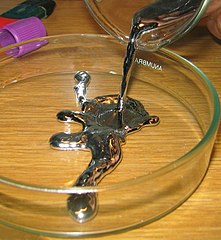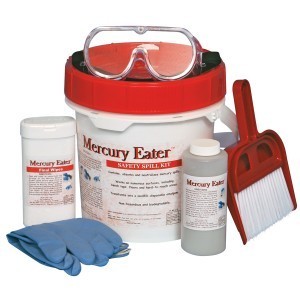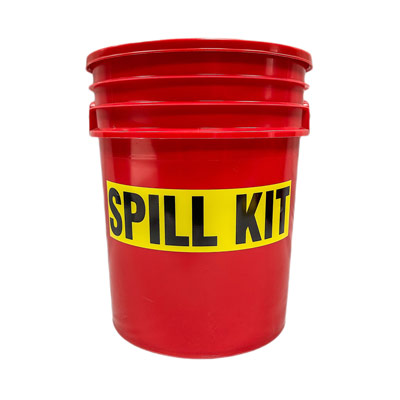Everything you need to know about mercury spill kits and safe clean up
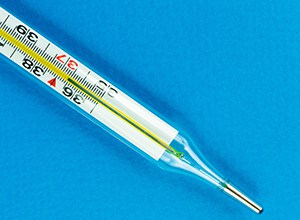
Mercury may be in thermometers, electrical components or dental fillings
Also referred to as quicksilver, liquid mercury is a highly toxic chemical that’s often found in a variety of workplace devices. Just a few examples include thermometers, barometers, and float valves. Often electric components, like switches and relays, contain mercury. It also remains in use in some fluorescent lighting and dental amalgam fillings. As well as scientific research laboratories, of course.
Have you ever seen this fascinating liquid metal in a school science lab? If so, you’ll remember it’s a completely unique substance to observe. It certainly behaves unlike most fluids or metals at room temperature.
But, it’s due to these unique characteristics that mercury spills require a different clean up approach. In the event of a spill, it’s important to follow proper mercury cleanup procedure. Otherwise, there’s a greater risk of mercury poisoning for anyone who comes into contact with it. Poisoning can occur through direct skin contact, absorption, vapor inhalation, or, ingestion.
Even minimum exposure to mercury can be deadly. Which is why specialty equipment is necessary for mercury spill control and clean up. That’s because this silver liquid metal easily breaks into small droplets and “scatters”. Using a mercury spill kit to absorb, neutralize and suppress mercury vapor is essential to minimize danger.
So to learn more about the do’s and don’ts of cleaning up a liquid mercury spill, keep reading.
Don’t: Use a vacuum cleaner on mercury spills
Never attempt to clean a liquid mercury spill using a vacuum cleaner. A vacuum’s suction pressure will force microscopic mercury particles into the air rather than containing it. This results in higher mercury exposure to anyone in the surrounding area.
A vacuum cleaner might seem like a good idea initially, but it’s far too dangerous to use with mercury. Spreading the mercury into the air creates a significantly more dangerous hazmat environment. So, keep the vacuum turned off!
Don’t: Sweep mercury with a broom
Another common mistake when cleaning liquid mercury spills is sweeping it with a broom. As previously stated, mercury possesses unique characteristics. One of which is the ability to ‘ball’ up rather than spread evenly, like water or water-based substances.
If you attempt to sweep liquid mercury with a broom, chances are you’ll only spread it around. Rather than having just a few large drops bunched together, you’ll have dozens or even hundreds of smaller drops scattered across the floor.
Do: Wear protective gear during mercury spill clean up
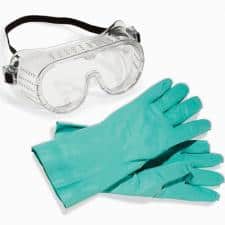
Thick latex or nitrile gloves and goggles are essentials when working with mercury spills
Always wear protective gear before attempting to clean up a mercury spill. Due to the high toxicity of liquid mercury, even skin contact is toxic. Don a pair of thick, professional-grade latex gloves along with protective safety goggles.
And remember that even with this PPE gear, you should avoid direct contact with liquid mercury.
Do: Use a squeegee for mercury cleanup
If you aren’t supposed to use a vacuum cleaner or broom, how exactly do you clean liquid mercury spills? Fortunately, the Environmental Protection Agency (EPA) offer helpful instructions about how to safely clean up mercury spills.
For example, it recommends using a squeegee or piece of cardboard to push mercury into a single pile. Next, use an eyedropper to transfer it into a damp paper towel. You can then place the mercury-filled paper towel into a sealed plastic bag. Lastly, contact your local health or fire department to have them properly dispose of the liquid mercury biohazard.
Mercury clean up kits 101
If your workplace has any equipment that contains mercury, having a specialized spill kit on site is a no brainer. Next, we’ll outline some of the basics about clean up kits and safely dealing with a mercury spill.
What’s in a mercury spill clean up kit?
A mercury spill kit contains all the essentials to safely clean, decontaminate, and dispose of the hazardous waste. The main content is typically a mercury absorbent, encapsulating, or amalgamation powder. Clean up tools will include a scraper, wipers, dust pan and disposal bags. Some types of kits may contain things like chemical sponges, aspirator bottle, or spatulas. All kits will contain appropriate PPE, such as thick nitrile gloves and goggles.
How do I use a mercury spill kit?
First, put on safety goggles and gloves. Next, sprinkle absorbency powder around the spill site to completely cover the mercury. The mercury absorbent powder bonds to, and transforms, droplets into a solid material like zinc amalgam. It also acts as a vapor suppressor to limit exposure to this toxic substance.
After a few minutes, sweep up the stabilized mercury using a hand broom and dust pan. Decontaminate the spill surface area with mercury clean up wipers to remove any residues. Finally, transfer all used kit hazmat materials into a disposal bag and seal it with a twist tie.
Shop chemical spill kits and more at AbsorbentsOnline.com
We offer a wide range of spill containment and hazmat clean up products for quick order.
Browse our mobile spill kits, battery acid spill kits, indicator powder neutralizers. Find spill control products like containment berms, absorbents, and wipers. We also stock containment pallets for IBC totes and overpacks. Not to mention a wide selection of safety cabinets and safety cans!
Contact us for advice about anything from storing hazardous materials, to spill containment.
This is a revision to a post with an original publish date of October 17, 2013
